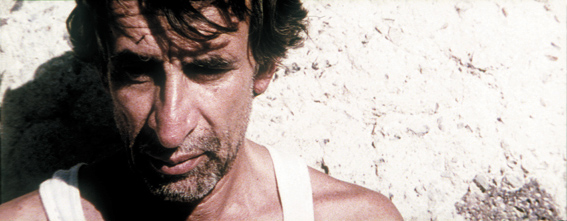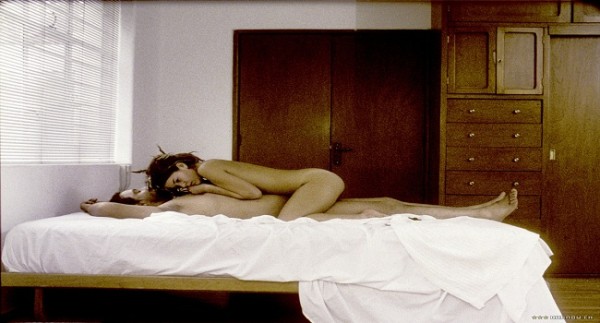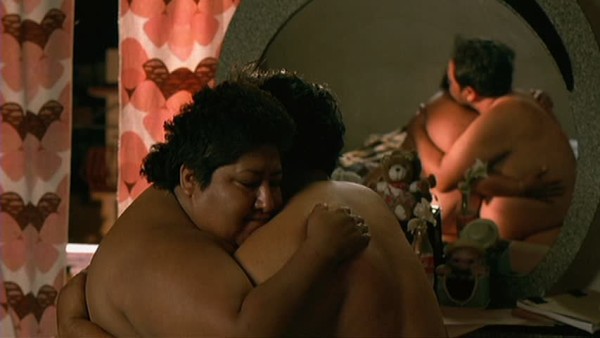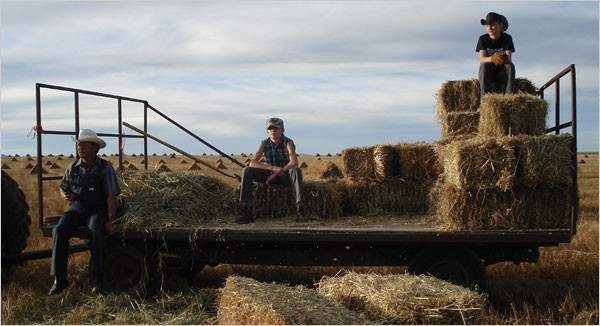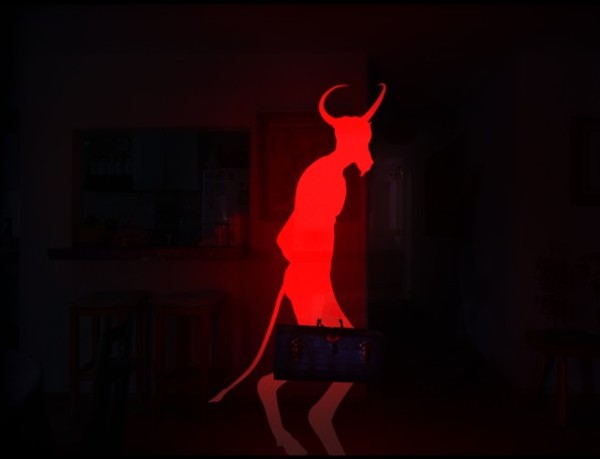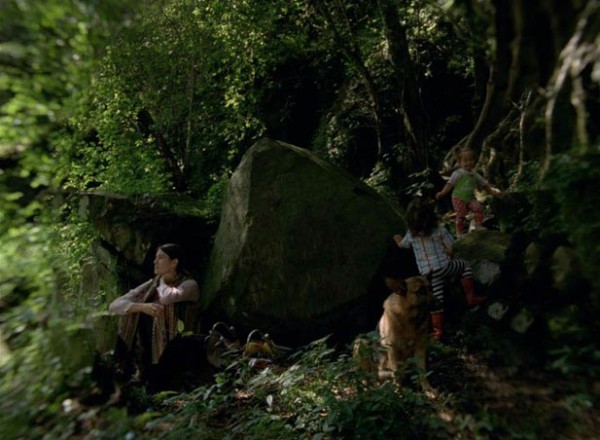Carlos Reygadas is a high-minded, wild thing out of Mexico City. He’s made four feature films, and all have screened at Cannes, where they were simultaneously harangued and cheered by critics. He employs a vintage camera and lenses and a small crew. The pictures are marvelous and totally out of sync with Hollywood norms. Reygadas is like a Romantic poet of the cinema; his films suggest that a love of humankind comes through Nature. They describe a cosmogenic imagination, in that each film is like an origin story and a meditation on the infinite. The images are, by turns: beautiful, hallucinogenic, brutal, erotic, and subversively funny.
What follows is a set of brief notes on his works to date, all of which I can recommend to you, Glasstire readers. (Spoilers ahead, though I think in these notes that’s beside the point.)
In his first film, Japón (2002), Reygadas introduces one of his hallmarks, which is pulling astonishing (and graphic) performances from non-actors. In it, an unnamed Man with a magnificent, craggy face (Alejandro Ferretis) leaves a densely populated city for a canyon in the wilderness. Amidst the rocky cliffs and peaceful quiet, he plans to kill himself. While mulling over his suicide, he stays with an elderly woman, Ascen (Magdalena Flores), who gives him shelter in her barn. When Ascen’s nephew returns to the canyon after a long stint in prison, he embarks on a plan to demolish the barn and carry the stones to a nearby village where he’ll make his new home. Ascen tells her guest that his shelter will soon be gone and so will her own modest hut, which will blow over from strong winds once the barn is no longer there to shield it. Ascen, a deeply religious woman, delivers the news of their eviction in a fateful way. She believes God will provide for her and the Man, wherever they each decide to go.
The Man’s confronts the nephew, and in doing so, his will to live takes the upper hand in his struggle between life and death. As this will awakens, so does his sex drive. He propositions Ascen in a direct way. Ascen, who is dedicated to the service of others, agrees.
Again, Ferretis and Flores are acting for the first time, and their courage in this explicit sex scene is extraordinary. It’s staged openly and without any pretense of romance. The Man, trying to cling to life, is clearly taking advantage of Ascen and her seemingly endless compassion. The light of his reawakening is overcast by the debasing way he moves Ascen into different positions. In a sense, she is giving over her life for his. It sets up the tragic ending of the film.
The film’s title is not descriptive. Japan is neither a location in the story nor a place that’s ever mentioned. It has to do with darkness and light occurring simultaneously: as night falls on one side of the world, dawn breaks on the other. Japón’s release announced Reygadas as a compelling manipulator of archetypical themes, a director who invests natural light and unspoiled locations into a grand style, and a teller of forbidding tales.
His next film, Battle in Heaven (2005), opens with a graphic scene of oral sex. The heavy, middle-aged man is Marcos (Marcos Hernández), and the beautiful young woman on her knees is Ana (Anapola Mushkadiz). The seashells woven into Ana’s dreadlocks signal her association with Venus. Here again Reygadas uses first-time actors for an explicit sex scene, and like the scene in Japón, the partner match is incongruous: this time it’s a fat older man and a striking young woman.
Later in the film, Marcos has sex with his wife Berta (Bertha Ruiz). These two are closer in body type and perform fully naked in a long scene. It almost seems like exploitation—this open display of obese bodies. But redemption is in the performances. A beautiful domesticity becomes apparent; the husband and wife are comfortable and forgiving of each other’s imperfections, and by extension, forgiving each other for a dreadful crime.
The plot of Battle in Heaven is hard-nosed. Marcos and Berta kidnap a baby but something goes wrong and the baby dies. Ana, the daughter of Marcos’ boss, is someone he has known since she was small. She trusts him with the secret that she works as a high-end prostitute and he trusts her with the details of his crime. Ana has a transcendental effect on Marcos. After sex with her he has a moment of clarity and plans to turn himself in, taking the whole blame upon himself. But the cosmogeny that guides the characters here is mysterious and shocking, just like the cosmogeny that guides Japón to its tragic conclusion. In a fit of self-loathing, Marcos does something terrible to Ana.
Battle in Heaven suffers for its urban setting. It seems Reygadas has little feel for the city. The film jumps to life with each appearance of Ana, but it only finds its poetry about halfway through, when Marcos and his family take a trip into the country. The nature sequence introduces a cosmic pitch in the life-and-death struggle going on with Marcos, and that pitch blares wildly in the final scene when heavily armed police officers confront Marcos at a festival for Our Lady of Guadalupe. The film would be better—glorious even—if the protracted commuter scenes in the first half of the film were replaced with ecstatic religious and sacrilegious scenes like those found in the second half.
Sex in Reygadas’ films is detailed, but not intended as kink. The bedroom scenes are openings for him to explore sexual mysteries of attraction, grace, and deviation. Sex is also a reflexive situation for him, in that the explicitness of these encounters defines Reygadas’ films against the mainstream of dominant commercial cinema, along with his preference for non-actors.
Reygadas’ refusal to work with professional actors continues in his next film, Silent Light (2007), and he hired Canadian novelist Miriam Toews for a key role as a Mennonite wife.
Toews, in turn, based a character on Reygadas in her novel Irma Voth (2011). In her novel, Reygadas is transfigured into the character of Diego, a celebrated Mexican filmmaker, who is described as having “sparks flying off him in every direction.” Diego rails against popular cinema, saying, “I hate actors… I hate narrative.” Also, “ I hate stories and photographs. They scare me. They freak me out. They’re dead. I want emotion, the feeling, the emotional resonance of the person, the character coming out of the shot, a painting.” In interviews included on DVD copies of Japón and Battle in Heaven, Reygadas sounds very much like Diego—a convivial man with provocative ideas about cinema and human nature.
Battle in Heaven is an uneven film, but Silent Light is one of tonal precision. Every scene radiates with emotion. It is set in a Mennonite community in Northern Mexico. Johan (Cornelio Wall) loves his wife Esther (Toews) and their many children. He also loves, and is perhaps spiritually drawn to, Marianne (Elizabeth Fehr). In one scene Johan climbs a hill to meet Marianne in secret. They kiss as sunlight flares across the camera lens like fireworks. In the next scene, Johan and Esther bathe their children at an idyllic riverbank. But this is not a film about lies or double lives. Johan is honest with Esther about Marianne. He says it is beyond his will to stay away from her. Esther is, of course, deeply hurt. But she is also sensitive to the spiritual battle happening within her husband. For her part, Marianne worries about her effect on Johan’s family. And she reckons with the stifling effect loving a married man has on her own life, and her stalled ambitions for having her own family.
This time Reygadas does not lead his actors into explicit sexual situations or drop them off after a violent climax that is at once absurd and biblical. This film leads the characters to witness a miracle, one that is presented with restraint and elegance, in a beautiful finale.
Reygadas’s most recent film is Post Tenebras Lux (2012), which is Latin for “After the darkness, light,” a phrase out of the Book of Job. It opens with a little girl stomping around in a wet field beneath dramatic storm clouds, chasing a herd of cows as a pack of dogs run back and forth around her. The scene carries on for a while, taking the viewer from dusk to pitch black. In the next scene, a red-hot animated devil enters a family’s home at night, carrying a toolbox. A little boy sees him but is fixed with amazement, unable to cry out. The devil notices the boy but doesn’t spend any time considering him. It seems the child is too innocent for the plans he has in mind. But the child’s parents are another matter. The boy can only watch with curiosity and fear as the devil carries his toolbox into the parents’ bedroom and closes the door.
Reygadas leaves the formalism of Silent Light for a dreamlike, brutal world. Once again the forces of darkness are equal to the forces of light. Post Tenebras Lux is ostensibly the story of Juan (Adolfo Jiménez Castro), an affluent man who moves his wife and children to the Mexican countryside. Two destructive factors close in on Juan like wolves. One is class struggle. Although Juan is at pains to show that he is not a gentrifying force in the small village that is his new hometown, his privileges make him a target of suspicion for the locals. The other force is his violent temper, something he tries to control through sex. Sex for him his not about intimacy, but rather it is the mechanical manipulation of his urges. His desire for wife Natalia (Nathalia Acevedo) comes across as a debasement to her.
The film is shot with a beveled lens that refracts the edges of the frame, leading to a mirrored effect that surrounds each scene, thus creating a dreamy and claustrophobic atmosphere. The nonlinear narrative style may be interpreted as a way of exploring Juan’s psyche from different points in time. It may also be interpreted as a collage of scenes depicting a struggle between natural and civilizing forces.
Although Silent Light is Reygadas’s most accomplished film, my favorites are Japón and Post Tenebres Lux. The long scenes of visionary landscapes fix my attention while also allowing my mind to wander. The hard sunlight falling on the wilderness in Japón reminded me of lines by Rainer Maria Rilke: “For here there is no place that does not see you. You must change your life.” And the doubling of images by the beveled lens in Post Tenebras Lux brought to mind the essays of Louis Blanqui, who wrote: “Our earth, as well as other celestial bodies, is the repetition of a primordial combination that is always reproduced in the same way and that exists simultaneously in thousands of identical copies.” These are experimental films that carve a place in the mind like epic poetry, and reveal a filmmaker thirsty and reckless for lasting, cinematic beauty.
Japón, Battle in Heaven, Silent Light, and Post Tenebras Lux area available to stream on MUBI.com, and Post Tenebras Lux is also available to stream through Amazon. All are available on DVD through Amazon and Netflix.



